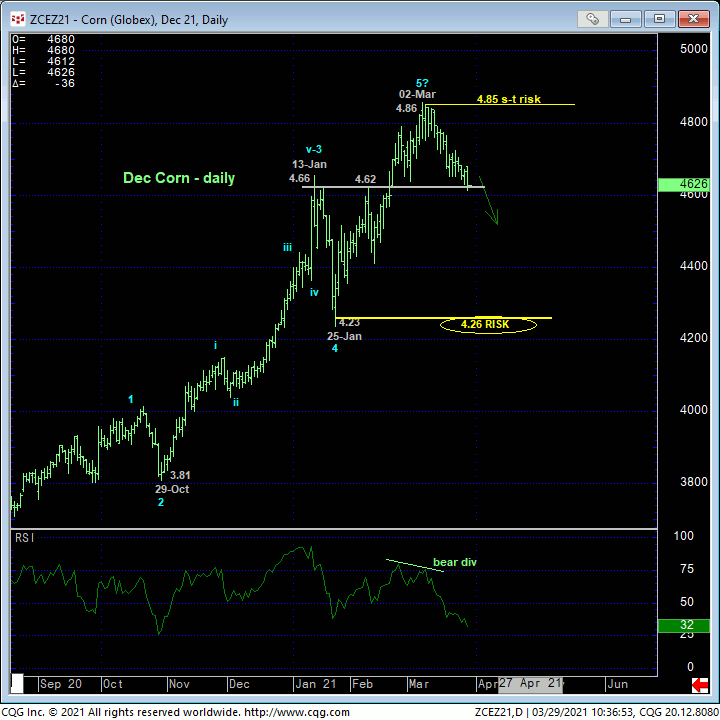
(Please Note: This update only addresses the technical construct and expectations for May and Dec corn heading forward. We will follow this analysis with one dedicated to option strategies to engage Wed’s critical crop report in what looks to be developing into an acute and unique trading/hedging opportunity).
MAY CORN
In 16-Mar’s Technical Blog, we discussed the market’s “weathering” of a prospective bull market consolidation that warned and may still warn of a resumption of the major bull trend. As a result of Thur’s bearish divergence in short-term momentum below 18-Mar’s 5.45-3/4 corrective low however, the market has identified 19-Mar’s 5.59 high as one of developing importance and our new short-term risk parameter it is now required to recoup to mitigate an alternate peak/reversal count and re-expose the secular bull trend. The fact that this admittedly short-term momentum failure occurred shy of 09-Feb’s 5.72 high resurrects a broader peak/reversal threat that contends the recovery attempt from 10-Feb’s 5.30 low is only a 3-wave and thus corrective structure as labeled in the hourly chart below.
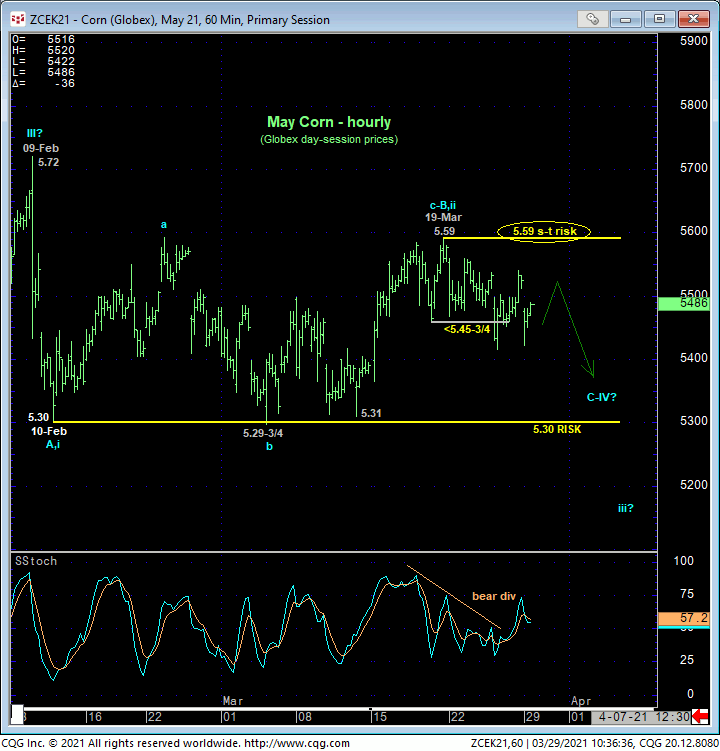
From a longer-term perspective however, minimum weakness below at least 10-Feb’s 5.30 Globex day-session low is required to confirm a bearish divergence in WEEKLY momentum that, along with broader sentiment, Elliott and Fibonacci elements we’ll discuss below, would leave the market vulnerable to a peak/correction/reversal count that could be major in scope. In effect, we believe the market has identified 5.30 and 5.59 as the key directional flexion points around which directional biases and exposure can and should be objectively toggled commensurate with one’s personal risk profile.
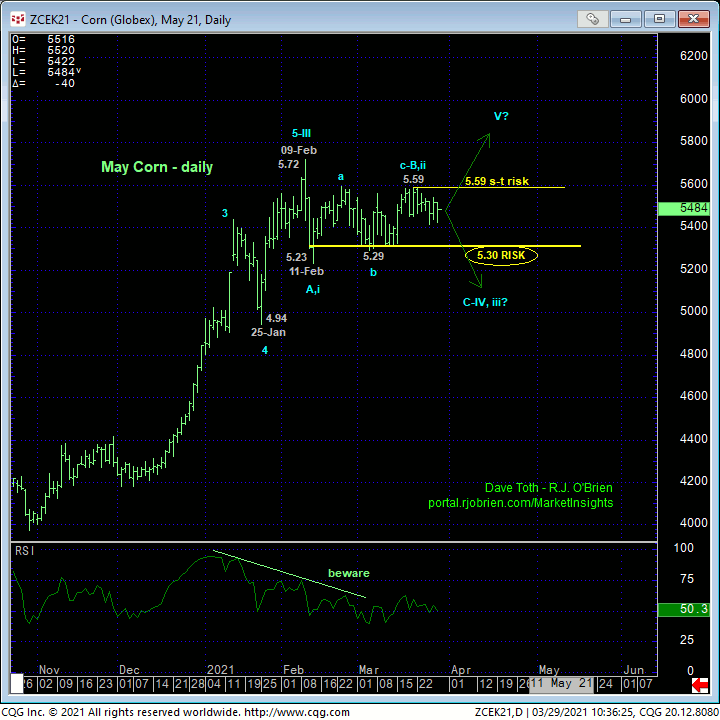
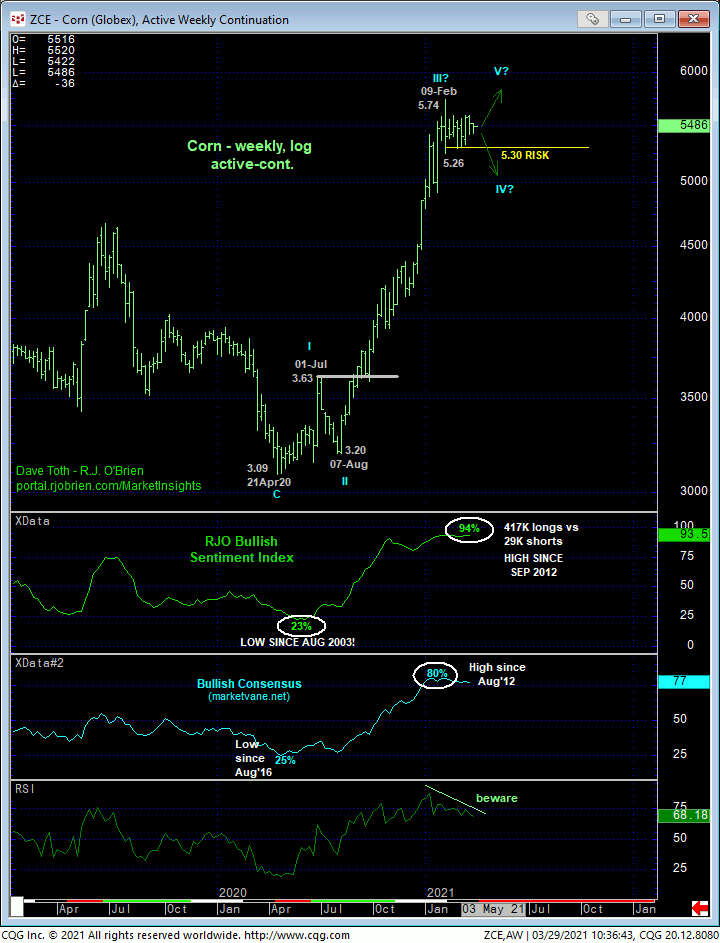
Stepping back further to consider the major 11-month bull, it’s debatable whether 09-Feb’s 5.72 high completed three or five waves up from 21Apr20’s 3.09 low. But with upside momentum that’s been waning since Jan and stratospheric sentiment/contrary opinion levels not seen since 2012’s infamous peak and reversal, the LAST thing we’re gonna worry about if this market fails below 5.30 is a theoretical wave count as downside risk below that point could be severe. Indeed, with a current 94% reading in our RJO Bullish Sentiment Index reflecting a whopping 417K Managed Money long positions to just 29K shorts, a massive amount of fuel for downside vulnerability is present. If this peak/reversal threat is wrong or premature, all the bull has to do is recoup our short-term risk parameter at 5.59.
Additionally, it may be more than coincidence that this market’s biggest bull move since 2010 stalled within 3-cents of the (5.77) 61.8% retrace of the entire 2012 – 2019 bear market from 8.49 to 3.09 on a monthly log scale basis below.
These issues considered, a bearish policy is advised for short-term traders from current 5.45-area prices OB with a recovery above 5.59 required to negate this call, warrant its cover and re-expose the secular bull. Longer-term commercial players remain OK to maintain a bullish stance with a failure below 5.30 required to threaten this call enough to warrant its immediate cover and reversal into a new bearish policy ahead of what could be protracted losses thereafter.
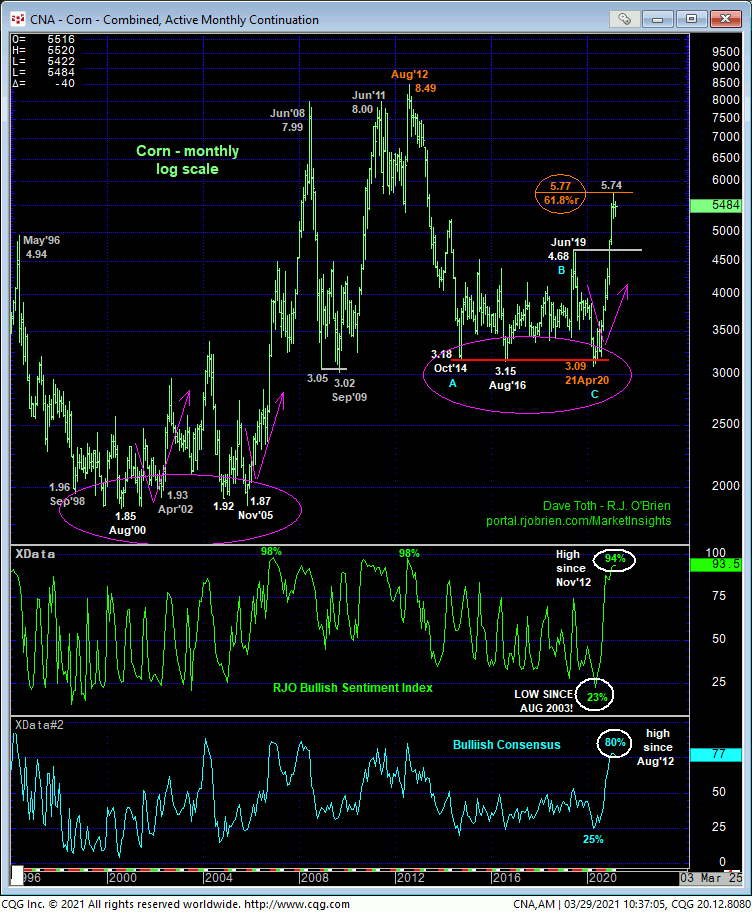
DEC CORN
The end of last week and today’s continued slide reinforces our peak/correction/reversal count introduced in 22-Mar’s Technical Blog and leaves highs in its wake at 4.73 and certainly 4.85 from which non-bearish decisions like long-covers and new bearish punts can be objectively rebased and managed. This continued weakness assures us that 09-Mar’s 4.85 high completed a 5-wave Elliott sequence and the uptrend from 25-Jan’s 4.26 Globex day-session low. This begs the question of whether this 4.26 – 4.85 portion of the bull is the completing 5th-Wave to a massive Elliott sequence that dates from last year’s low.
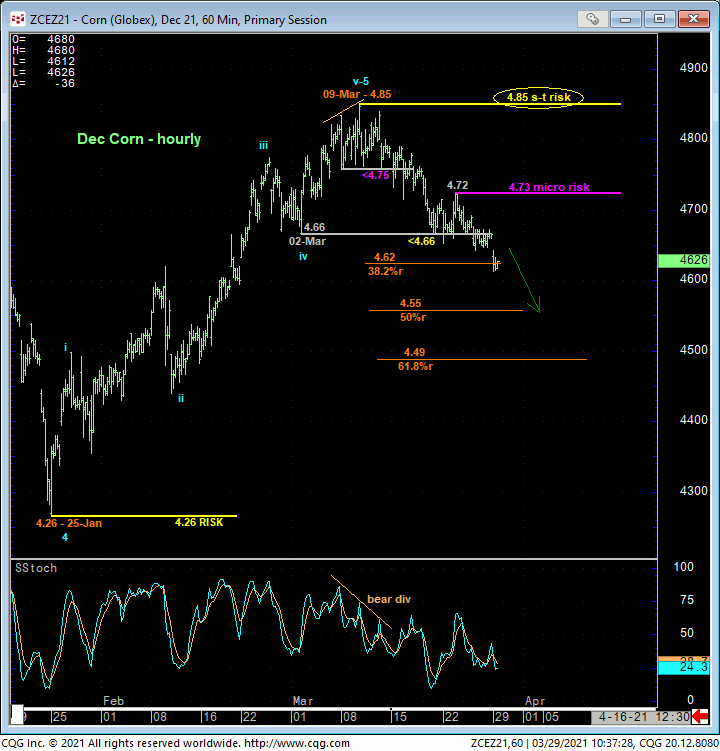
Stepping back to the daily chart of the Dec contract, it is clear that 25-Jan’s 4.26 Globex day-session low is THE longer-term level this market needs to break to, in fact, break the major uptrend from Apr’20’s 3.57 low. Until such commensurately larger-degree weakness is proven, we cannot ignore the prospect that the current relapse isn’t just a slightly larger-degree BULL market correction. But again, with market sentiment/contrary opinion as such frothy levels, waning upside momentum on a weekly basis and that pretty much exact 61.8% retrace of the entire 2012 – 2019 bear, the last thing we want to be relying on for preferred directional bets is a theoretical wave count.
The daily chart below shows obvious former resistance from the 4.60-area that, since broken in late-Feb, should not surprise as a new support candidate now. A clear break below this 4.60-area would be the next nail in the bull’s coffin. As for what the market would have in store between 4.60 and 4.26, that’s anybody guess and brings the key issue of technical and trading SCALE into the equation. The market has certainly fallen off enough to render a bearish policy appropriate for shorter-term traders, with a recovery above at least 4.73 and preferably 4.85 required to threaten and then negate this call. On a broader scale, commensurately larger-degree weakness below 4.26 remains arguably required to break the bull on a scale pertinent to longer-term commercial players. Longer-term players have the option however to pare or neutralize bullish exposure around current 4.61-area prices and acknowledge and accept whipsaw risk (back above 4.73 and/or 4.85) in exchange for deeper nominal risk below 4.26.
